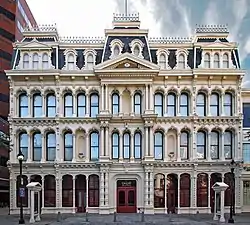Masonic Hall and Grand Theater | |
 The Grand Opera House from the northwest | |
  | |
| Location | 818 N Market St, Wilmington, Delaware |
|---|---|
| Coordinates | 39°44′38″N 75°32′55″W / 39.743852°N 75.548649°W |
| Built | 1871 |
| Architect | Thomas Dixon, Charles L. Carson |
| Architectural style | Second Empire |
| Website | www |
| NRHP reference No. | 72000294 |
| Added to NRHP | December 11, 1972[1] |
The Grand Opera House, also known as The Grand or Masonic Hall and Grand Theater, is a 1,208-seat theater for the performing arts in Wilmington, Delaware, United States. The four-story building was built in 1871 by the Delaware Grand Lodge of Masons to serve as a Masonic Temple and auditorium. The construction cost was $100,000.[2] It was designed in Second Empire style by Baltimore architect Thomas Dixon and incorporates symbolism from Freemasonry into the cast-iron facade. Its central pediment contains an Eye of Providence.
Historically, the Grand hosted a variety of operas, symphonies, Victorian melodramas, minstrel shows, burlesque, vaudeville, and other exhibitions, including performers such as Ethel Barrymore, "Buffalo Bill" Cody and "Texas Jack" Omohundro, and John Philip Sousa. For most of the twentieth century the Grand was operated exclusively as a movie theater, run by Warner Brothers from 1930 and eventually closing in 1967. It was reopened four years later and returned to programming emphasizing classical music, partnering with the Delaware Symphony Orchestra, OperaDelaware, and the First State Ballet Theatre.
It was listed on the National Register of Historic Places in 1972 with assertions of both architectural and historical significance. It was argued it is "one of the finest remaining examples of 19th century cast iron architecture in America" and that it has important association with events and persons in Delaware's history.[1][3]
In 1973, management was turned over to a non-profit organization and the building underwent extensive restoration, which was completed in 1976.
See also
References
- 1 2 "National Register Information System". National Register of Historic Places. National Park Service. March 13, 2009.
- ↑ History of the Grand Archived 2010-08-05 at the Wayback Machine, The Grand website, accessed July 31, 2010
- ↑ Robert Dick Stoddard Jr. (July 1972). "National Register of Historic Places Inventory-Nomination: The Masonic Hall and Grand Theater / The Masonic Temple and Grand Opera House". National Park Service. and Accompanying two photos, exterior and interior, from 1971
External links
- Grand Opera website
- First State Ballet website
- OperaDelaware website
- Delaware Symphony Orchestra website
- Historic American Buildings Survey (HABS) No. DE-170, "Masonic Hall & Grand Theater, 818 North Market Street, Wilmington, New Castle County, DE", 6 photos, 3 data pages, 1 photo caption page
- Grand Opera House - Wilmington, Wanda Kaluza, video

